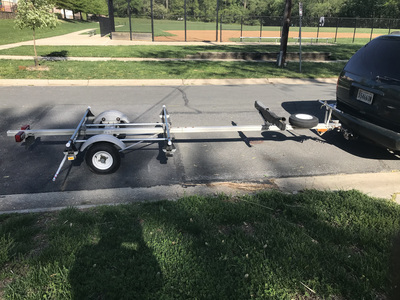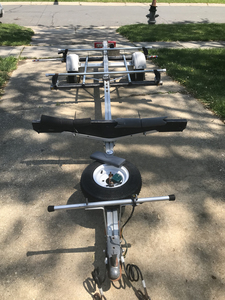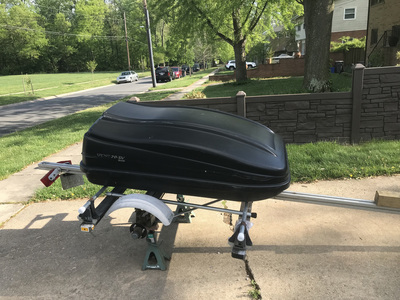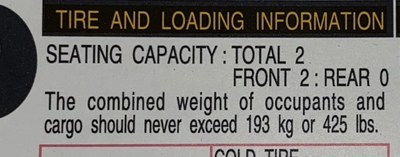What is your estimate of that total weight? I cut the tongue on my carry rack as short as possible to reduce the bending moment about the pass-through holes in the steel bumper.
I make Amateur Armrests - see the Commercial Forum. I also have SMT repair seals available.
I considered getting one of those teeny teardrop trailers and mounting my bicycle on that, then heading out into the wild. I’m dreaming and perhaps I’ve used the excuse that I do not believe those welds, either the nut itself or the frame/bumper support that nut is tack welded to, can hold too much weight. Personally, I would not want to use the tow hook to actually pull the car up a tow truck ramp or out of a ditch. The catastrophe to me would be the damage to the bodywork more than snapping a simple weld.
http://www.ispot.tv/ad/73yV/geico-motorcycle-no-shame
I have thought about adding small motor cycle trailer for long road trips then I think about a nice twisty road a have visions of the trailer flopping side to side and bouncing down the road as I unknowingly accelerate though all the fun bends.
Have you guys looked at the vehicle's rated cargo carrying capacity, listed in the yellow sticker in the driver's door jam? Mine states 425lbs. That includes passengers and any other added weight which would include trailer tongue weight and anything else carried or attached. If you exceed the CCC, the vehicle suspension and braking is being worked beyond it's limits. If you're careful and don't go to the extremes you're probably OK. But 2 chunky occupants doesn't leave much of a margin for cargo.
Dave
Since spyders can out-stop almost any other car on the road, I’m not too concerned about brake capacity. I think the spyder brakes are oversized past any safety limits, and could easily handle more mass. My 2GR swap carries 200-300 lbs extra weight from the engine, plus passengers. I’ve never overheated the brakes even on track day.
I make Amateur Armrests - see the Commercial Forum. I also have SMT repair seals available.
Still thinking about the overload question. I know my spyder can stop much quicker than a Ford Expedition, and the Expedition is safe enough to register. Plus my spyder can out corner any Ford Expedition. So when my spyder gets so overloaded that it performs like an Expedition, then has it become too dangerous to drive? I suppose tongue weight that squashes the springs flat is obviously a limit. I’ve heard the “too much weight on the rear axle” argument about my 2GR. Yet the front/rear weight distribution is far better than a 1965 Ford Mustang - even with the 200lb heavier engine in the rear. I’ll bet I could add another 200 lbs to the engine and still have a better front to rear weight balance than a Mustang. (Of course the Mustang is nose heavy). Then I’ve heard the complaint that my trailer hitch storage rack will “upset the handling”. Like I go run track days with a loaded storage rack! 😀
I make Amateur Armrests - see the Commercial Forum. I also have SMT repair seals available.
I go through my life with a "Don't Follow Me" sign on my back. However,
Actual --- not theoretical at all --- Spyder cargo carrying capacity:
Failed Trailer Hitch: probably around 300#.
Hauling ability on, mostly 3 cylinders --- pre-cat failure --- Driver+Luggage+Euro 6 Speed+1ZZ complete engine+all new fluids/belts/hoses+10 quarts of oil (see pre-cat failure): I estimate at well over 600#. Car performed well at speed on the flats. Hills caused predictable slow down/down shifts. Extreme hills/grade 15%, breakdown lane in whatever gear it took to haul it up without straining. Gas mileage dropped to around 27 MPG.
Braking issues, absolutely no change. Wallowed slightly, not alarmingly, in turns. (Bear in mind this is with already blown struts.)
IMHO, the Spyders hauling capacity is not the issue. The questions are: how much weight can the "tacked" tow nuts haul (one answer, less than 300# on a storage rack; I suspect this amount of weight MIGHT have been fine if the load were balanced on a lightweight trailer). How much weight can the fully welded tow nuts haul? How much weight can the reinforced AND fully welded tow nuts haul?
At the beginning of the Spring, I raised the idea of hauling a small trailer --- camping equipment, cooler, bicycle, etc.) cross country on SC. Lots of negative feedback... but one guy had already actually done it with standard tow nuts. Someone else successfully hauls a small trailer with 4 tires for track days (can't remember about tow nut weld reinforcement).
Around mid Spring, I actually bought a lightweight (130#) all aluminum kayak trailer
and started modifying it --- I have already purchased an 8' roto-molded cargo carrier box to add to the trailer ---- for a planned cross country trip.
Unfortunately, I took a bad fall and was unable to: either finish the trailer build and/or take the cross country trip.
However, I plan on continuing to work on the trailer over the winter so that it will be ready when I am for the cross country trip. Based upon my trailer's weight carrying capacity, I can only haul 350#, for a total weight of less than 600#. I am trying to keep the cargo weight as low as possible but, just a single cooler filled with supplies and ice weighs almost 100#, a MTN bike and rack adds around another 40#. Most everything else (tent, tent poles, table, folding chairs, clothes, sleeping bag, lanterns) is more bulky than heavy....but it all adds up.
Prior to hauling the trailer ---- loaded or unloaded --- I plan AT A MINIMUM to have the towing nuts welded around the entire perimeter as much as is practible. Depending upon the welder, they may require that the nuts also be enclosed in some sort of metal brackets prior to being welded in.
The way I am approaching the whole towing nut issue is AT WORST: after they are welded in place, they should support a trailer hitch with a bike rack; or a storage rack; and probably a decent sized cooler full of drinks and ice.
The way I am approaching the whole towing nut issue is AT BEST: after they are welded in place, they easily and successfully pull my "Cross Country" trailer.
If worst-comes-to-worse, I have already set, as a fall back position, that I will have to use my minivan to pull the "Cross Country" trailer and the Spyder will be staying home for the duration of the trip.
Stay tuned.
Paul
Cargo capacity has nothing to do with towing capability or rating. My Suburban is rated at 8,300lbs towing but the CCC is only 1,505lbs. Low option pickup trucks have the best cargo capacity because they have less weight. The Spyder apparently has less margin than some of you believe.
Personally, I wouldn't worry about it but I thought it was worth mention.
Dave
But towing capacity relies on the trailer having wheels correct? So any rack built from this hitch without wheels would be considered cargo.But if you add wheels then it's towing.
Seems that the welds on the nuts can't handle much weight anyway so my point is moot.
2000 Toyota MR2 Spyder, 2021 Lexus UX 250h F Sport
But towing capacity relies on the trailer having wheels correct? So any rack built from this hitch without wheels would be considered cargo.But if you add wheels then it's towing.
Seems that the welds on the nuts can't handle much weight anyway so my point is moot.
Part of the trailer weight is transferred to the car (and subtracts from the CCC number) via trailer tongue, 'tongue weight'. It's supposed to be around 10-15% of the trailer's total weight otherwise an imbalance can cause instability.
halo, agree the point is moot as Spyders dont have a tow rating I've ever seen. This is all backyard engineering which is fine. Just be careful!
Dave
The owners manual states:
"Toyota does not recommend towing a trailer with your MR2. It is not designed for trailer towing."
Now, why did they put in those lightweight nuts, complete with pop-out trim on the bumper, which is clearly intended for the end-user?
CYA. I don't know what they are called, but my unqualified opinion is that you could safely load up to 100 lbs, well-balanced, on one of those trailers that has two caster-mounted wheels and two connection points at the front corners.
You might also get away with a jet ski trailer (lightest DOT-approved platform I have been able to find).
I dont think any version of cargo platform, anything unsupported by wheels, is prudent for much more than the weight of a bicycle or two, even with reinforcement of the fragile Spyder Nuts, which probably ought to be done in any and every case. Just to be cautious.
I think the warnings about torque on the frame, handling characteristics, and so forth are going to be realistic and considerable once you start placing significant weight at some distance behind the rear axle, and much much more so if it it unsupported by additional wheels.
🐸, 2003, Electric Green Mica
The owners manual states:
Now, why did they put in those lightweight nuts, complete with pop-out trim on the bumper, which is clearly intended for the end-user?
LOL, clearly. I'm sure you know they are tow hook screw-in point. My theory is they were tacked-in for 1 time use as the car can't take too many crashes before it is scrap.
Dave
I have to agree with this. The frame attachment where the tow hook threads into is pretty strong but I can see that fatiguing given enough time. The few times I had to have my car towed onto a flat bed using that attachment point to pull the car made it creek. I believe the Spyder can tow a set of wheels for an AutoX but I wouldn't put my faith in it for anything else including jailbreaks or tooth extraction.
This is an absolute long shot: is there anyone on this Forum who has access to glue on/adhesive stress gauges? Or knows of a place to buy a couple of them without breaking the bank?
I was thinking that this might be able to quantify all of the thoughts and concerns all of us have regarding the strength/structural integrity of using the tow nuts for any weight bearing application.
Paul
Paul, we dont need that! We already know it is a number between zero and whatever a transmission and some fluid weighs... plus five miles.
(Sorry, had to)
Dev, you must have some seriously strong teeth!
Actually, I wonder if the Spyder Nuts are there for use during assembly of the car. Seems odd to go to such lengths and I cannot imagine needing them after the bumper is on, but otherwise they must be for towing.
Even with a swivel-wheel trailer, there is still going to be sideways torque. Actually, it probably just shifts the forces from vertical to lateral, and, since the wheels swivels, there isn't going to be much help resisting any lateral force coming from the tires. It may in fact be inferior to a traditional trailer, but I am still betting doughnuts that is better than a zero-wheel trailer. However, the lateral force is controllable with steering, vertical force has no relief except for trailer wheels.
Always a trade-off. Matter is preserved, thermodynamics is an equation and not an inequality, etc. I'd really like to hear from a towing expert about these swivel-wheel setups. The mfrs have great things to say, of course...
🐸, 2003, Electric Green Mica




